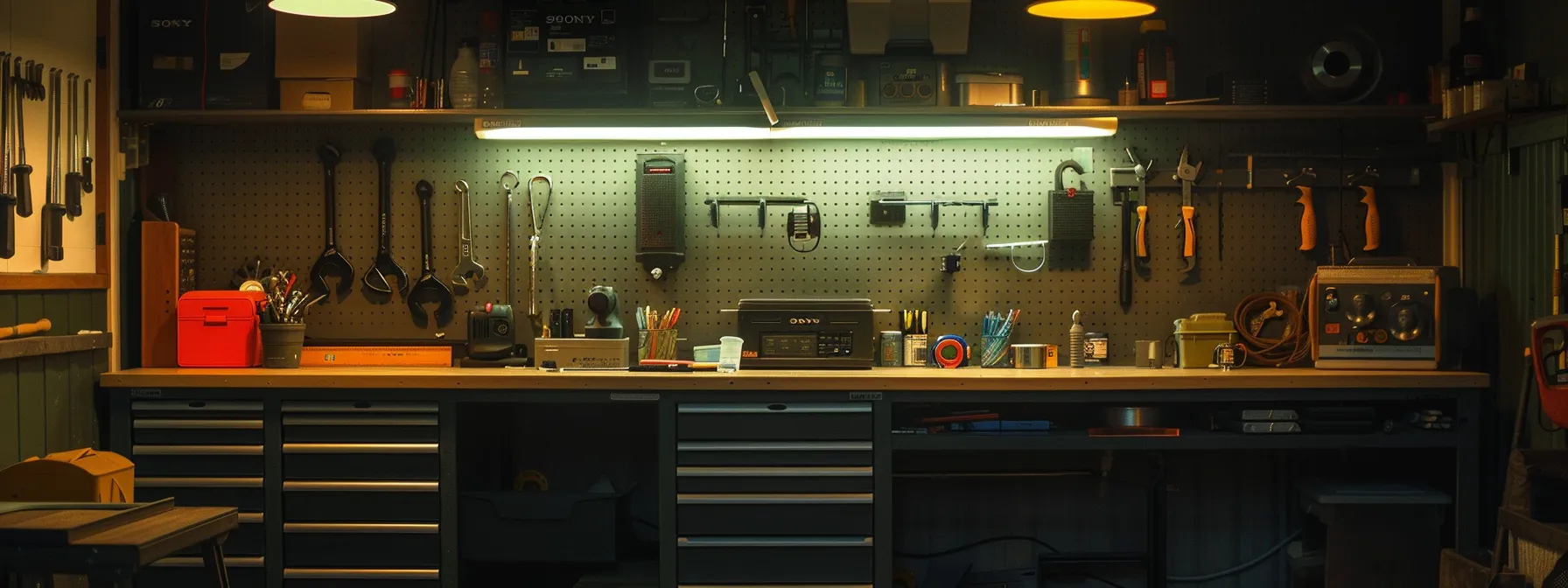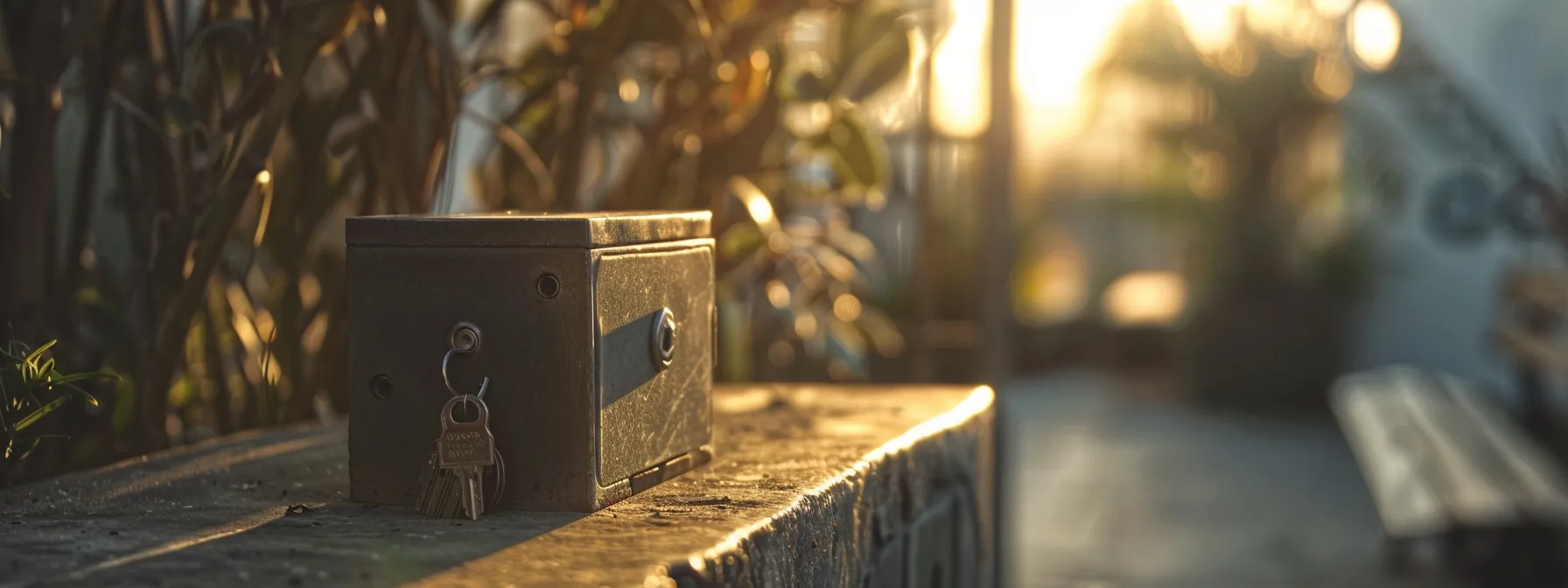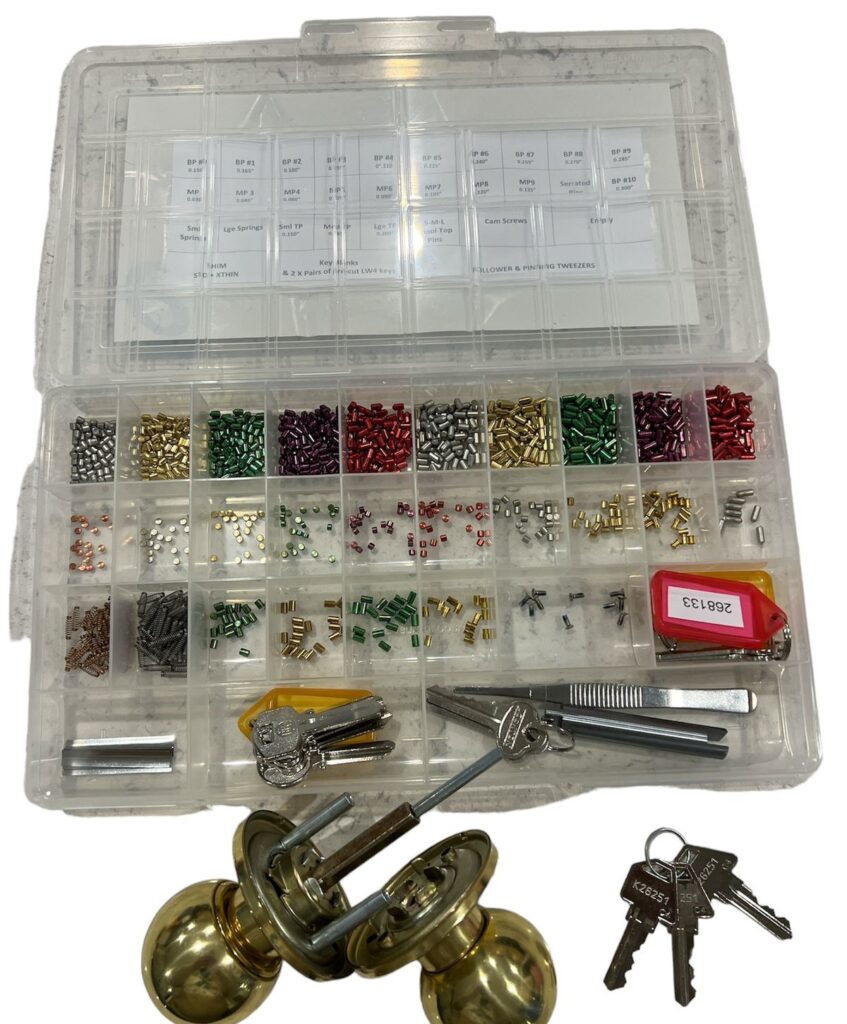Are you concerned about the security of your property and the risk of burglary? Installing an outdoor keysafe can provide a reliable solution. This guide will cover the essentials of outdoor keysafe security, how to select the ideal keypad model for your needs, and a step-by-step installation process, including masonry tips for secure mounting. By following this comprehensive installation guide, readers will learn how to enhance their safety and ensure easy access to their door key without compromising security. Protecting your home starts with the right setup, and this article will help you achieve that.
Understanding the Essentials of Outdoor Keysafe Security

Installing a secure outdoor keysafe offers numerous benefits, including enhanced access control and protection against theft. Understanding potential risks, such as unauthorized access, is crucial for effective Business Lockout Solutions. Additionally, compliance with local regulations and insurance policies ensures that the setup meets safety Residential Locksmith Services standards. This section will explore these key aspects, providing practical insights for a successful installation.
Reasons to Install a Secure Outdoor Keysafe
Installing a secure outdoor keysafe is essential for effective key storage, providing a reliable solution for homeowners, Residential Locksmith Services, Business Lockout Solutions, and businesses alike. It allows for controlled access to keys, reducing the risk of unauthorized entry while ensuring that trusted individuals can easily retrieve them when needed. With the right tools, such as a screwdriver for installation and a pencil for marking placement, securing a keysafe in concrete can be a straightforward process that enhances overall security.
- Controlled access to keys
- Reduced risk of unauthorized entry
- Easy retrieval for trusted individuals
- Straightforward installation process
Potential Risks and How to Mitigate Them
When installing an outdoor keysafe, potential risks such as improper mounting can lead to unauthorized access. To mitigate these risks, it is essential to use the correct tools, including Business Lockout Solutions a drill and a torx bit, to securely fasten the keysafe to the wall. Additionally, utilizing Residential Locksmith Services wall plugs ensures that the screws hold firmly, providing a robust installation that deters tampering and enhances overall security.
Compliance With Local Regulations and Insurance Policies
Compliance with local regulations and insurance policies is a critical aspect of key safe installation. Homeowners and businesses must ensure that their Residential Locksmith Services outdoor keysafe meets safety standards set by local authorities, which may include specific requirements for mounting on brick or concrete surfaces. Additionally, verifying that the installation aligns with insurance policies Business Lockout Solutions can prevent potential claims issues, ensuring that the property remains protected in case of theft or damage.
Now that the essentials of outdoor keysafe security are clear, it’s time to choose the right one. The right keysafe can make all the difference in keeping your property secure.
Selecting the Ideal Keysafe for Your Needs

Selecting the ideal keysafe involves comparing various types to find the best fit for specific needs. Evaluating security features and certifications is essential for ensuring reliable protection. Additionally, considering material durability and weather resistance will enhance longevity. Reviewing top-rated brands and models can provide valuable insights, making it easier to choose the right solution for both residential and commercial Locksmith Services Business Lockout Solutions.
Comparing Types of Outdoor Keysafes
When comparing types of outdoor keysafes, it is essential to consider features such as security ratings, locking mechanisms, and material durability. For instance, some models offer digital keypads, while others utilize traditional combination locks, catering to different preferences and security needs. Home Lockout Services often recommend keysafes that provide robust protection against tampering and weather elements, ensuring that keys remain secure and accessible for trusted individuals during emergencies. Residential Locksmith Services
Evaluating Security Features and Certifications
When evaluating security features and certifications for outdoor keysafes, it is vital to consider the level of protection they offer. Look for models that have been tested and certified by recognized security organizations, as these certifications indicate a reliable standard of safety. Features such as tamper-proof designs, weather resistance, and robust locking mechanisms are essential for ensuring that the keysafe can withstand both environmental elements and unauthorized access.
Considering Material Durability and Weather Resistance
When selecting an outdoor keysafe, considering material durability and weather resistance is essential for long-term functionality. A keysafe made from high-quality materials, such as heavy-duty metal or reinforced plastic, can withstand harsh weather conditions, including rain, snow, and extreme temperatures. This durability not only protects the keys inside but also ensures that the keysafe remains secure against tampering and wear over time:
Reviewing Top-Rated Brands and Models
When reviewing top-rated brands and models of outdoor keysafes, it is essential to consider their reputation for security and durability. Brands such as Master Lock and Kidde are known for their reliable locking mechanisms and weather-resistant designs, making them suitable for various environments. Evaluating customer reviews and expert recommendations can provide valuable insights into the performance and longevity of these products, helping users make informed decisions that align with their security needs:
With the right keysafe chosen, the next step awaits. Preparing for installation will ensure your security is set firmly in place.
Preparing for Installation

Before installing a secure outdoor keysafe, it is essential to gather the necessary tools and materials, select an optimal location for enhanced security, and take safety precautions. This section will outline the specific tools required for installation, guide the selection of a suitable location, and emphasize important safety measures to ensure a successful setup. Each of these elements plays a crucial role in achieving effective key storage and access control.
Tools and Materials You’ll Need
To successfully install a secure outdoor keysafe, it is essential to gather the right tools and materials beforehand. Key items include a drill with appropriate drill bits for the mounting surface, a screwdriver for securing screws, and wall plugs to ensure a sturdy installation. Having these tools on hand not only streamlines the installation process but also enhances the overall security of the keysafe, addressing potential concerns about unauthorized access.
Choosing the Optimal Location for Security
Choosing the optimal location for a secure outdoor keysafe is critical for maximizing security and accessibility. It is advisable to install the keysafe in a discreet area that is not easily visible to passersby, as this reduces the risk of tampering or theft. Additionally, placing the keysafe near a well-lit area can enhance visibility for trusted individuals while deterring potential intruders, ensuring that access remains safe and controlled.
Safety Precautions to Take Before Installation
Before installing a secure outdoor keysafe, it is vital to take specific safety precautions to ensure a smooth and secure setup. Users should wear protective gear, such as gloves and safety goggles, to prevent injuries while handling tools and materials. Additionally, ensuring that the installation area is clear of obstacles and hazards will facilitate a safer working environment, reducing the risk of accidents during the installation process:
The tools are ready, and the spot is chosen. It’s time to move forward with the step-by-step guide to installing your outdoor keysafe.
Step-by-Step Guide to Installing Your Outdoor Keysafe

Marking the drilling points accurately is the first step in ensuring a secure outdoor keysafe installation. Following this, proper drilling and mounting techniques are essential for a stable setup. Securing the keysafe firmly to the surface will enhance its resistance to tampering. Finally, setting up and testing the access code or key mechanism guarantees reliable access for authorized users. Each of these steps is crucial for achieving optimal security and functionality.
Marking the Drilling Points Accurately
Marking the drilling points accurately is a critical step in the installation of an outdoor keysafe. This process ensures that the keysafe is securely mounted, reducing the risk of unauthorized access. To achieve precise markings, users should hold the keysafe against the chosen surface and use a pencil to indicate where the screws will go, ensuring that the placement is level and aligned properly. This attention to detail not only facilitates a smoother installation but also enhances the overall security of the keysafe:
- Hold the keysafe in position against the surface.
- Use a pencil to mark the drilling points.
- Ensure the markings are level and aligned.
Proper Drilling and Mounting Techniques
Proper drilling and mounting techniques are essential for ensuring a secure outdoor keysafe installation. Users should begin by selecting the appropriate drill bit for the mounting surface, whether it be brick, concrete, or wood, to create clean, precise holes. Once the holes are drilled, inserting wall plugs will provide additional support for the screws, enhancing the keysafe’s stability and resistance to tampering. This attention to detail not only secures the keysafe effectively but also minimizes the risk of unauthorized access, addressing a primary concern for homeowners and businesses alike.
Securing the Keysafe Firmly to the Surface
Securing the keysafe firmly to the surface is a critical step in the installation process that directly impacts its effectiveness and security. Users should ensure that the screws are tightened adequately and that wall plugs are used to provide additional support, especially when mounting on harder surfaces like brick or concrete. This attention to detail not only prevents the keysafe from being easily removed but also enhances its resistance to tampering, addressing the primary concerns of homeowners and businesses seeking reliable key storage solutions.
Setting Up and Testing the Access Code or Key Mechanism
Setting up and testing the access code or key mechanism is a vital step in ensuring the functionality of an outdoor keysafe. Users should carefully follow the manufacturer’s instructions to input the desired access code, ensuring it is memorable yet secure. After setting the code, it is essential to test the mechanism multiple times to confirm that it operates smoothly and reliably, providing peace of mind that only authorized individuals can access the keys stored inside.
- Marking the drilling points accurately
- Proper drilling and mounting techniques
- Securing the keysafe firmly to the surface
- Setting up and testing the access code or key mechanism
The keysafe is in place, a silent guardian of your home. Next, it is time to fortify your security with essential post-installation measures.
Post-Installation Security Measures

Verifying the integrity of the installation is crucial for ensuring the security of an outdoor keysafe. Effective concealment of the keysafe can deter potential tampering, while regular maintenance is essential for longevity. Additionally, updating access codes periodically enhances security. This section will provide practical insights into these key aspects, ensuring that the keysafe remains a reliable solution for secure key storage.
Verifying the Integrity of the Installation
Verifying the integrity of the installation is essential to ensure that the outdoor keysafe remains secure and functional. Users should regularly check the mounting screws and wall plugs to confirm they are tight and undamaged, as loose fittings can compromise security. Additionally, testing the access mechanism periodically helps to identify any potential issues before they become significant problems, ensuring that only authorized individuals can access the keys stored within the keysafe.
Tips for Concealing Your Keysafe Effectively
Concealing an outdoor keysafe effectively is vital for enhancing security and deterring potential tampering. Users should consider placing the keysafe in less visible locations, such as behind shrubs or near outdoor fixtures, to minimize exposure. Additionally, using decorative elements, like garden ornaments or planters, can help blend the keysafe into the surroundings, making it less noticeable to intruders while still accessible for trusted individuals.
Regular Maintenance to Ensure Longevity
Regular maintenance of an outdoor keysafe is essential for ensuring its longevity and continued effectiveness. Users should routinely inspect the keysafe for any signs of wear or damage, paying close attention to the locking mechanism and mounting screws. Additionally, cleaning the keysafe to remove dirt and debris will help maintain its functionality and appearance, ensuring that it remains a reliable solution for secure key storage over time.
Updating Access Codes Periodically for Enhanced Security
Updating access codes periodically is a vital practice for enhancing the security of an outdoor keysafe. Regularly changing the access code minimizes the risk of unauthorized entry, especially if the code has been shared with multiple individuals or if there is a concern about potential breaches. By implementing a schedule for code updates, property owners can ensure that only trusted individuals have access to the keys, thereby maintaining a secure environment for their home or business.
With your security measures in place, the next step is to ensure they are used wisely. Understanding the best practices for your outdoor keysafe will keep your property safe and your mind at ease.
Best Practices for Using Your Outdoor Keysafe

Implementing best practices for using an outdoor keysafe is essential for maintaining security and accessibility. Safely sharing access with trusted individuals ensures that only authorized users can retrieve keys. Integrating the keysafe with home security systems enhances overall protection. Monitoring for unauthorized access attempts and responding to security alerts promptly are crucial for safeguarding property. Each of these practices contributes to a secure and efficient keysafe setup.
Safely Sharing Access With Trusted Individuals
Safely sharing access to an outdoor keysafe with trusted individuals is essential for maintaining security while ensuring convenience. Property owners should provide access codes only to those who genuinely need it, such as family members or trusted friends, and avoid sharing codes through unsecured channels. Regularly updating the access codes and monitoring who has access can further enhance security, ensuring that only authorized users can retrieve keys when necessary:
- Limit access to trusted individuals only.
- Share access codes securely.
- Regularly update access codes.
- Monitor access to the keysafe.
Integrating Your Keysafe With Home Security Systems
Integrating an outdoor keysafe with home security systems significantly enhances overall protection. By connecting the keysafe to a security system, property owners can receive alerts for unauthorized access attempts, ensuring timely responses to potential threats. This integration not only provides peace of mind but also streamlines access for trusted individuals, allowing them to retrieve keys securely while maintaining a robust security framework.
Monitoring for Unauthorized Access Attempts
Monitoring for unauthorized access attempts is a critical practice for maintaining the security of an outdoor keysafe. Property owners should regularly check for any signs of tampering or forced entry, as this vigilance can help identify potential security threats early. Utilizing security cameras or motion sensors near the keysafe can provide additional layers of protection, alerting users to any suspicious activity and ensuring that only authorized individuals can access the stored keys.
Responding to Security Alerts and Issues Promptly
Responding to security alerts and issues promptly is essential for maintaining the integrity of an outdoor keysafe. Property owners should establish a clear protocol for addressing alerts, such as checking for signs of tampering or unauthorized access immediately. This proactive approach not only enhances security but also ensures that any potential threats are dealt with swiftly, safeguarding the keys stored within the keysafe:
- Establish a clear protocol for responding to alerts.
- Check for signs of tampering or unauthorized access immediately.
- Address potential threats swiftly to maintain security.
Conclusion
A secure outdoor keysafe setup is vital for enhancing access control and protecting against unauthorized entry. Proper installation, including selecting the right location and using appropriate tools, ensures the keysafe remains tamper-resistant and functional. Regular maintenance and updating access codes further bolster security, allowing trusted individuals to retrieve keys safely. By following these comprehensive guidelines, property owners can significantly improve their security measures and safeguard their homes or businesses effectively.


